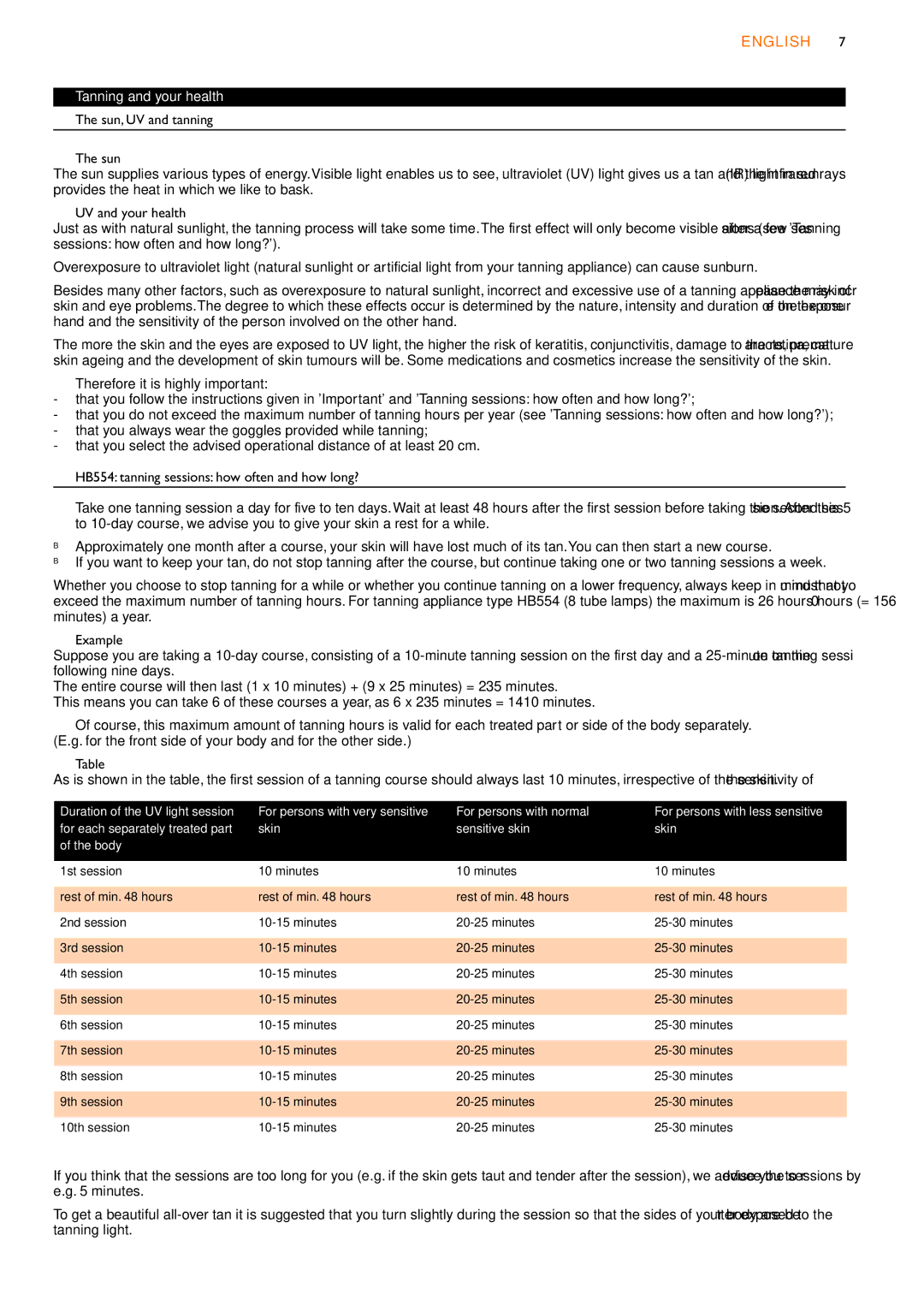
ENGLISH 7
Tanning and your health
The sun, UV and tanning
The sun
The sun supplies various types of energy.Visible light enables us to see, ultraviolet (UV) light gives us a tan and the infrared (IR) light in sunrays provides the heat in which we like to bask.
UV and your health
Just as with natural sunlight, the tanning process will take some time.The first effect will only become visible after a few sessions (see 'Tanning sessions: how often and how long?').
Overexposure to ultraviolet light (natural sunlight or artificial light from your tanning appliance) can cause sunburn.
Besides many other factors, such as overexposure to natural sunlight, incorrect and excessive use of a tanning appliance may increase the risk of skin and eye problems.The degree to which these effects occur is determined by the nature, intensity and duration of the exposure on the one hand and the sensitivity of the person involved on the other hand.
The more the skin and the eyes are exposed to UV light, the higher the risk of keratitis, conjunctivitis, damage to the retina, cataracts, premature skin ageing and the development of skin tumours will be. Some medications and cosmetics increase the sensitivity of the skin.
◗Therefore it is highly important:
-that you follow the instructions given in 'Important' and 'Tanning sessions: how often and how long?';
-that you do not exceed the maximum number of tanning hours per year (see 'Tanning sessions: how often and how long?');
-that you always wear the goggles provided while tanning;
-that you select the advised operational distance of at least 20 cm. HB554: tanning sessions: how often and how long?
◗ Take one tanning session a day for five to ten days. Wait at least 48 hours after the first session before taking the second session. After this 5 to
BApproximately one month after a course, your skin will have lost much of its tan.You can then start a new course.
BIf you want to keep your tan, do not stop tanning after the course, but continue taking one or two tanning sessions a week.
Whether you choose to stop tanning for a while or whether you continue tanning on a lower frequency, always keep in mind that you must not exceed the maximum number of tanning hours. For tanning appliance type HB554 (8 tube lamps) the maximum is 26 hours hours (= 1560 minutes) a year.
Example
Suppose you are taking a
The entire course will then last (1 x 10 minutes) + (9 x 25 minutes) = 235 minutes. This means you can take 6 of these courses a year, as 6 x 235 minutes = 1410 minutes.
◗Of course, this maximum amount of tanning hours is valid for each treated part or side of the body separately. (E.g. for the front side of your body and for the other side.)
Table
As is shown in the table, the first session of a tanning course should always last 10 minutes, irrespective of the sensitivity of the skin.
Duration of the UV light session | For persons with very sensitive | For persons with normal | For persons with less sensitive |
for each separately treated part | skin | sensitive skin | skin |
of the body |
|
|
|
|
|
|
|
1st session | 10 minutes | 10 minutes | 10 minutes |
|
|
|
|
rest of min. 48 hours | rest of min. 48 hours | rest of min. 48 hours | rest of min. 48 hours |
|
|
|
|
2nd session | |||
|
|
|
|
3rd session | |||
|
|
|
|
4th session | |||
|
|
|
|
5th session | |||
|
|
|
|
6th session | |||
|
|
|
|
7th session | |||
|
|
|
|
8th session | |||
|
|
|
|
9th session | |||
|
|
|
|
10th session |
If you think that the sessions are too long for you (e.g. if the skin gets taut and tender after the session), we advise you to reduce the sessions by e.g. 5 minutes.
To get a beautiful
